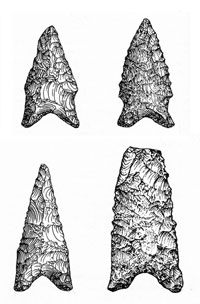
Dalton points from northeast Texas and
Oklahoma. From Johnson, 1989, courtesy Texas Historical Commission.
Click images to enlarge
|
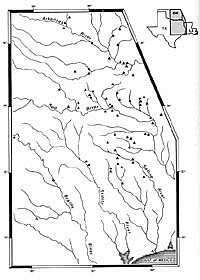
Distribution of Dalton points. From Johnson,
1989, courtesy Texas Historical Commission.
|

Late Archaic (or early Woodland) dart points
and stone tools from the Coral Snake site on the Louisiana
side of the Sabine River in what is now Toledo Bend Reservoir.
All of these artifacts made from local materials, mostly fossilized
wood.
|

Early drawing of Poverty Point site in
northeast Louisiana. The Poverty Point earthworks included
a huge bird-shaped mound more than 70 feet (21 m) high and
710 feet (216 m) in length and a unique C-shaped array of
raised berms arranged into six concentric and nested rings
that are nearly three-quarters of a mile across (3,950 feet
or 1.2 km) at the widest point.
|
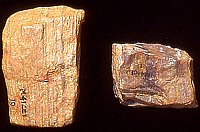
Petrified wood is one of the few materials
suitable for making chipped stone tools that is found in the
southwestern part of the Caddo Homeland (i.e., northeast Texas).
It was heavily used by Late Archaic times even though the
resulting dart points and tools were rather crude by comparison
to those made of flint (chert). These examples are from Cherokee
County. TARL archives.
|
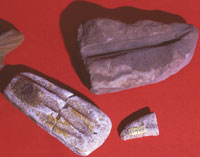
Grooved stones such as these from the George
C. Davis site were part of the tool-making kit of Late Archaic
(and later) peoples in northeast Texas. The material is Catahoula
sandstone, which outcrops in the area. TARL archives.
|

Early to Late Archaic artifacts from the
Wolfshead site in San Augustine County, Texas near the Sabine
River in what is now Toledo Bend Reservoir. TARL archives.
|
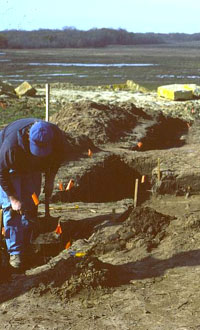
Excavations in progress at the Hurricane
Hill site overlooking the South Sulphur River in Hopkins County,
Texas. This site contained Late Archaic, Woodland, and Early
to Middle Caddo components, although these were often difficult
to separate. Courtesy Tim Perttula.
|
|
The earliest peoples who lived in the area
that would become the Caddo Homeland were highly mobile hunters
and gatherers during the early Paleoindian era at the end
of the last ice age (Pleistocene), some 12,000-13,500 years ago
(10,000-11,500 B.C.). (A growing body of evidence suggests that people arrived in
North America thousands of years earlier, but the earliest evidence is
debated.) Early Paleoindian points including the Clovis and Folsom
styles have been found in the area as have distinctive lanceolate
spear and dart points dating to later Paleoindian cultures.
By around 8,000 B.C. artifacts of the Dalton and San
Patrice cultures are particularly common in the Southeast, suggesting
that populations are growing and that different cultures were developing.
Within the Caddo Homeland, evidence of Dalton culture is found mainly
to the north, while that of San Patrice is mainly to the south.
Beyond the region, Dalton points are concentrated in the Mississippi
Valley and are especially numerous in northeast Arkansas. These
contrasting patterns may reflect an early split between ethnic/linguistic
groups. We do not know how this inferred split relates to later peoples.
Dalton and San Patrice are considered by many archeologists
to be among the first of many Archaic cultures (or the latest Paleoindian groups) in the Southeastern
United States around 10,000 years ago, named for the distinctive dart points made by their
hunters. The entire Archaic period spans 7,500 years between
roughly 8,000 B.C. and 500 B.C. The Archaic concept was originally
proposed as a developmental stage during which mobile hunting cultures
gradually became more settled and more reliant on wild plants, small
game, and aquatic resources. In the broad sense, this view remains
accurate, but we now realize that Archaic cultures were quite varied
and responsible for many of the cultural developments once thought
to date to the succeeding Woodland era. For example, permanent or
semi-permanent village settlements, pottery, horticulture (gardening),
artificial earthen mounds, and extensive, long-distant trade of
exotic materials all appeared during Archaic times in various places
in the Southeast.
While most of the seemingly more advanced Archaic cultures
are known from areas hundreds of miles to the east and northeast
of the Caddo area, some very important developments took place in
the lower Mississippi Valley immediately to the east and southeast.
For instance, in what is today northeastern Louisiana, Archaic
peoples began building large earthen mounds as early as 4,000 B.C.
These were not burial mounds, but apparently served as platforms
upon which people lived. At Watson Brake near Monroe, Louisiana,
11 mounds 3 to 25 feet (1-8 meters) tall are connected by ridges
to form an oval enclosure over 850 feet (261 meters) across. The
Archaic mounds of Louisiana are all located adjacent to now-abandoned
river channels and were built by hunting and gathering peoples who
exploited the local swampy environments rich in aquatic life including
fish, fowl, and beast.
In the same region around 1700 B.C., massive
earthworks were built at the site of Poverty Point by peoples
who depended on aquatic and riverine resources. The Poverty Point
earthworks included a huge bird-shaped mound more than 70 feet (21
m) high and 710 feet (216 m) in length and a unique C-shaped array
of raised berms arranged into six concentric and nested rings that
are nearly three-quarters of a mile across (3,950 feet or 1.2 km)
at the widest point. Poverty Point is thought by many experts to
have been the center of a precocious society with far-flung trade
connections as indicated by the finding of many artifacts made of
exotic or non-local stone (some coming from sources hundreds of
miles away). These exotic items may have been sent to Poverty Point
in exchange for shell beads and ornaments, produced at Poverty Point
and at linked sites on the Gulf coast. For reasons yet unclear Poverty
Point culture had declined by 1000 B.C. and left no obvious successor.
As far as we now know, the later Archaic peoples living
in the Caddo Homeland did not build earthen mounds or form societies
comparable to the one responsible for Poverty Point. Late Archaic
groups in the region did participate at least indirectly in the
Poverty Point trade network. This is known because a variety of
artifacts have been found at Poverty Point that are made of materials
such as novaculite and quartz from the Ouachita Mountains. But Late
Archaic groups in the Caddo Homeland area seem to have been relatively
small societies who were not closely connected to the main areas
of the Eastern Woodlands where precocious developments were taking
place.
One such development was the beginning of plant domestication
and horticulture (gardening). In the past few decades archeologists
and ethnobotanists (specialists in how ancient peoples used plants)
have demonstrated that at least four plants were domesticated in
the Eastern Woodlands by 4,000 to 5,000 years ago (2000-3000 B.C.).
Through selective manipulation squash, sunflower, marsh elder, and
chenopodium (goosefoot) were all transformed from wild plants to
crop plants with larger seeds and other desirable characteristics.
The best evidence comes from only a few caves and open sites in
the American Midwest that have extraordinary preservation conditions.
The nearest one to the main Caddo Homeland is the Phillips Spring
site in the Ozark Plateau of southern Missouri, less than 300 miles
to the north of the Red River. Domesticated squash and bottle gourd
seeds found at Phillips Spring have been radiocarbon dated to at
least 5,000 years ago.
The discovery that these starchy and oily seed plants
were being cultivated in Middle and Late Archaic times has shattered
the traditional notion that the Archaic cultures of the Eastern
U.S. were purely hunters and gatherers. Clearly, Archaic peoples
were experimenting with plant cultivation and probably all sorts
of other manipulations of the natural environment such as selective
clearing, spreading desirable plants to new areas, and so on. Archeologists
are now reevaluating existing ideas about Archaic life.
Were the Late Archaic ancestors of the Caddo also
experimenting with gardening and growing starchy and oily seed plants?
We do not know. The view here is that it is very likely that some
Late Archaic groups in the Caddo Homeland area began experimenting
with planting seeds obtained through trade and exchange from peoples
to the north and northeast. But so far we do not have any "smoking
gun" evidence—preserved domesticated seeds. This is at
least partly due to prevailing preservation conditions and the lack
of concerted effort to recover the needed evidence from Late Archaic sites. This is a prime
research issue in need of more work.
What do we know about Late Archaic peoples in the
Caddo Homeland? The Late Archaic period between roughly 3000-500
B.C. in the Caddo Homeland remains rather poorly known. Isolated
and well-preserved Late Archaic site components (discrete deposits
from a single period or use episode) are uncommon and not many have
been studied. Nonetheless, Late Archaic-style dart points with expanding
and contracting stems including, among others, the Yarborough, Ellis,
and Edgewood types, are widely distributed throughout the area and,
at many sites, are more numerous than earlier styles. In much of
the region, Archaic lifeways seem to have persisted longer than
elsewhere in the Eastern Woodlands.
Compared to earlier periods, the Late Archaic seems
to have been a time of higher populations and of more intensive
use of the landscape—sites are found on all landforms from
major river terraces to upland ridges and everything in between.
At some sites, particularly in valleys on the north side of the
Ouachita Mountains and in the Great Bend area of Red River, refuse
middens (essentially, kitchen trash dumps) begin to accumulate in
Late Archaic times. The best known is the Wister phase of the Wister
Valley in far eastern Oklahoma. There, "black middens"
began to form in Late Archaic times. The Fourche Maline culture,
in part, represents an intensification of this settlement pattern
during the succeeding Woodland period. The presence of places with
dense refuse accumulations in Late Archaic times suggests that people
were becoming less mobile and staying in certain highly favorable
localities for extended periods of time.
Another interesting observation is that Late Archaic
peoples were making extensive use of local stones to make tools.
Why is this interesting? Because, except in areas such as the Ouachita
Mountains, most of the local stones in the Caddo area are of poor
quality and occur in small cobbles that are ill-suited to make nicely
finished stone tools (such as dart points, knives, and wood-working
tools). For instance, in parts of east Texas a commonly used material
was fossilized or petrified wood. The fact that Late Archaic people were using
such materials suggests two things. First, that they were not traveling
far to find serviceable, if minimally so, raw materials. Second,
there was not much trade with peoples in other areas (such as the
Ouachitas or central Texas) who had access to plenty of high quality
material.
Late Archaic peoples in the area appear to have been
hunters and gatherers as before, depending on a wide variety of
mammals, fish, birds, seeds, nuts, berries, and roots. Deer was
the most important large game animal, but the bones of many different
critters are found in Late Archaic middens. There is some evidence
for increased emphasis on the gathering and processing of nuts—especially
hickory. While hickory nuts are tough nuts to crack, their oily
meats are both flavorful and an important source of fat and protein.
Evidence for the increased reliance on hickory comes from the large
number of "nutting stones" (stones with small pitted cups
that held hickory nuts securely during cracking) and the frequent
recovery of charred nut hulls in Late Archaic sites. To extract
all the fat, the cracked hickory nuts were probably stone boiled
by dropping hot rocks into a nut and water slurry in tightly woven
baskets or skin pouches, and the fat is skimmed off the top.
In the Cypress Creek basin in northeast Texas evidence
has also been found for the use of roots—underground tubers
of the Psoralea family (common names include scurfy pea,
prairie turnip, and breadroot). Preparing tubers for eating is a
labor-intensive process. They had to be located, dug up, baked or
boiled, and then dried (or eaten immediately). The two advantages
of tubers are that they are available when nothing else is and that
they can be dried and stored for later use.
Putting all this together, across the Caddo Homeland
area we see evidence of people settling down into localized territories
and intensively using local resources, even those that were not
particularly desirable. This suggests that regional population levels
were high enough that there were no large unoccupied territories
into which people could easily move in tough times. People started
staying put or staying in smaller territories because their options
were limited. While we cannot point to any one Late Archaic site
and say with certainty, "This is where ancestors of the Caddo
lived," we have little doubt that Caddo ancestors were already
living in what would become their homeland. We also think that the
conditions were set for the cultural developments that were to take
place in the succeeding Woodland period.
|

San Patrice points from northeast Texas
and Oklahoma. From Johnson, 1989, courtesy Texas Historical
Commission.
|

Distribution of San Patrice points. From
Johnson, 1989, courtesy Texas Historical Commission.
|
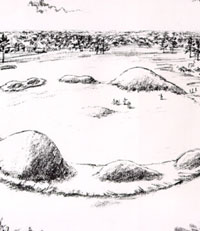
"Watson Brake Archaic Mound Site,"
an interpretive charcoal sketch by Martin Pate. Courtesy National
Park Service, Southeast Archeological Center.
|
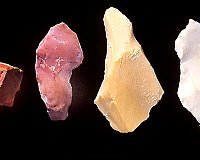
Flakes of novaculite from outcrops in the
Ouachita Mountains of southwest Arkansas. Novaculite was quarried
and used by prehistoric peoples in and near the Ouachitas
for thousands of years. Artifacts made of novaculite are occasionally
found in Archaic, Woodland, and Caddo period sites over much
of the Caddo Homeland. TARL archives.
|
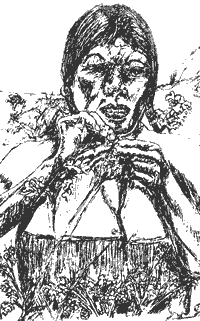
Artist Terry Russell's depiction of a Caddo
woman and her child collecting seeds from goosefoot (Chenopodium
sp.), one of the starchy seed crops domesticated in the Eastern
Woodlands by 2000 B.C. Drawing courtesy of the Arkansas Archeological
Survey.
|

Nutting stones such as these from the George
C. Davis site are common in Late Archaic sites. The material
is ferruginous sandstone which outcrops locally. TARL archives.
|
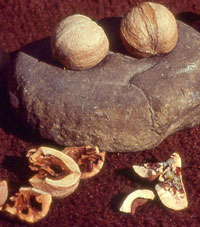
Hickory nuts were an important food throughout
Caddo history and probably long before. These tough-shelled
nuts were high in fat and protein, but difficult to shell
and extract. Pitted "nutting" stones, such as those
shown here, are found in Archaic, Woodland, and Caddo sites.
Photograph by Frank Schambach.
|
|